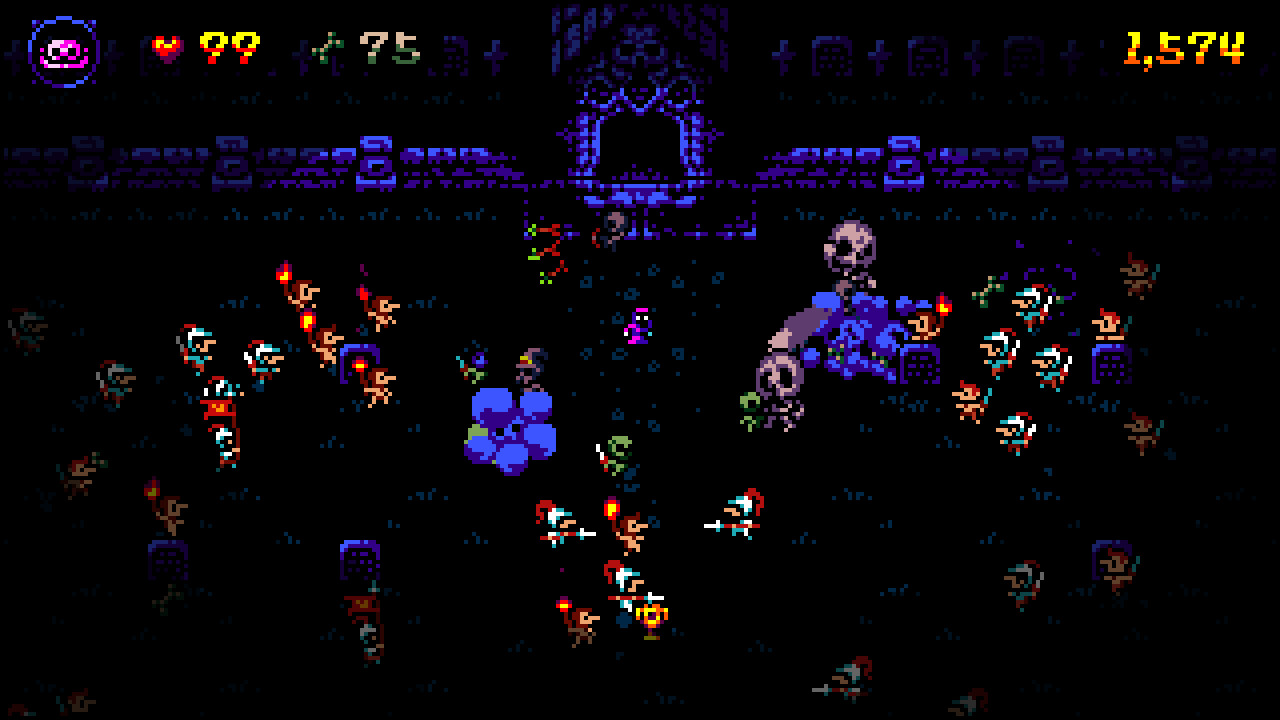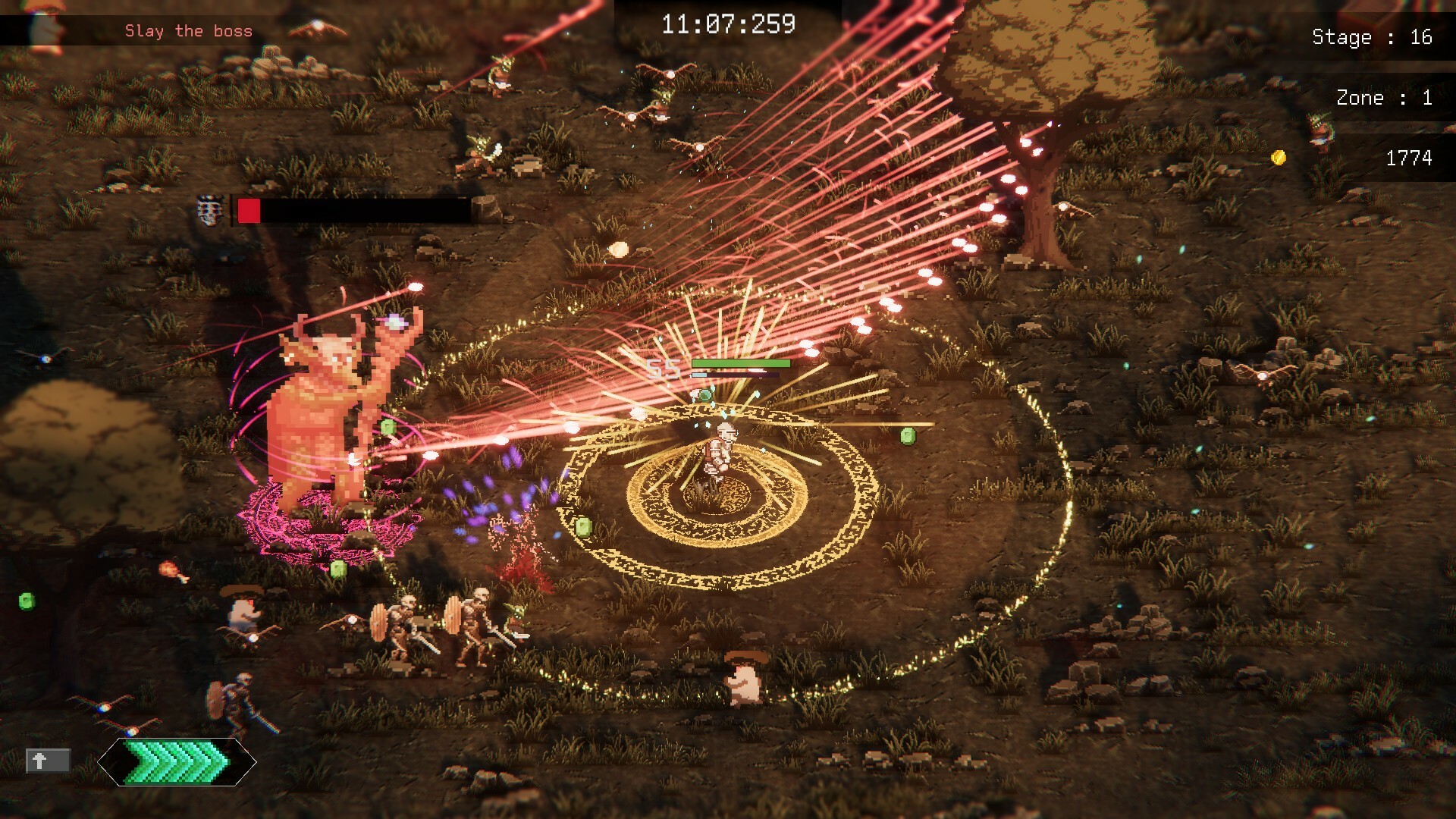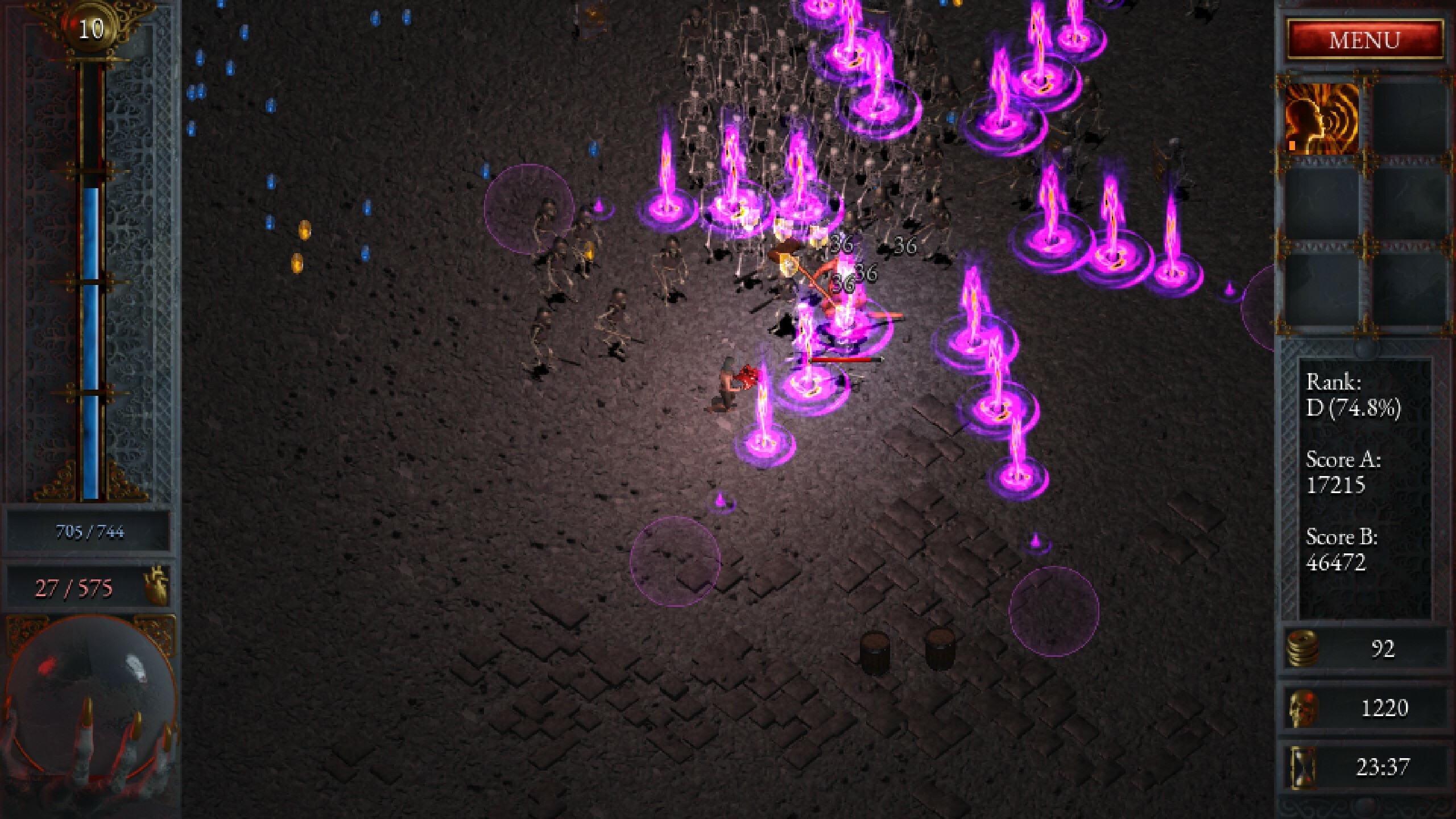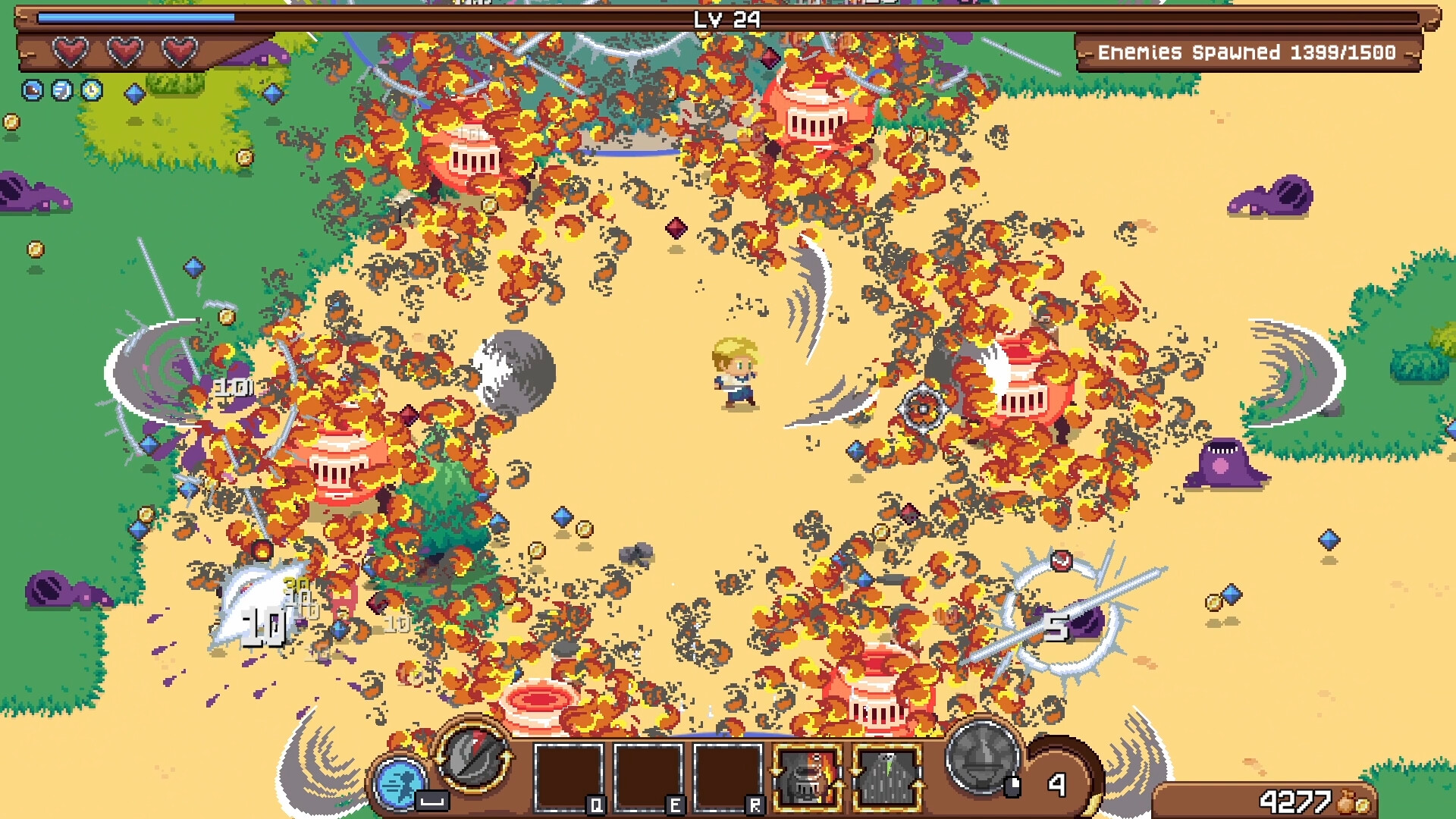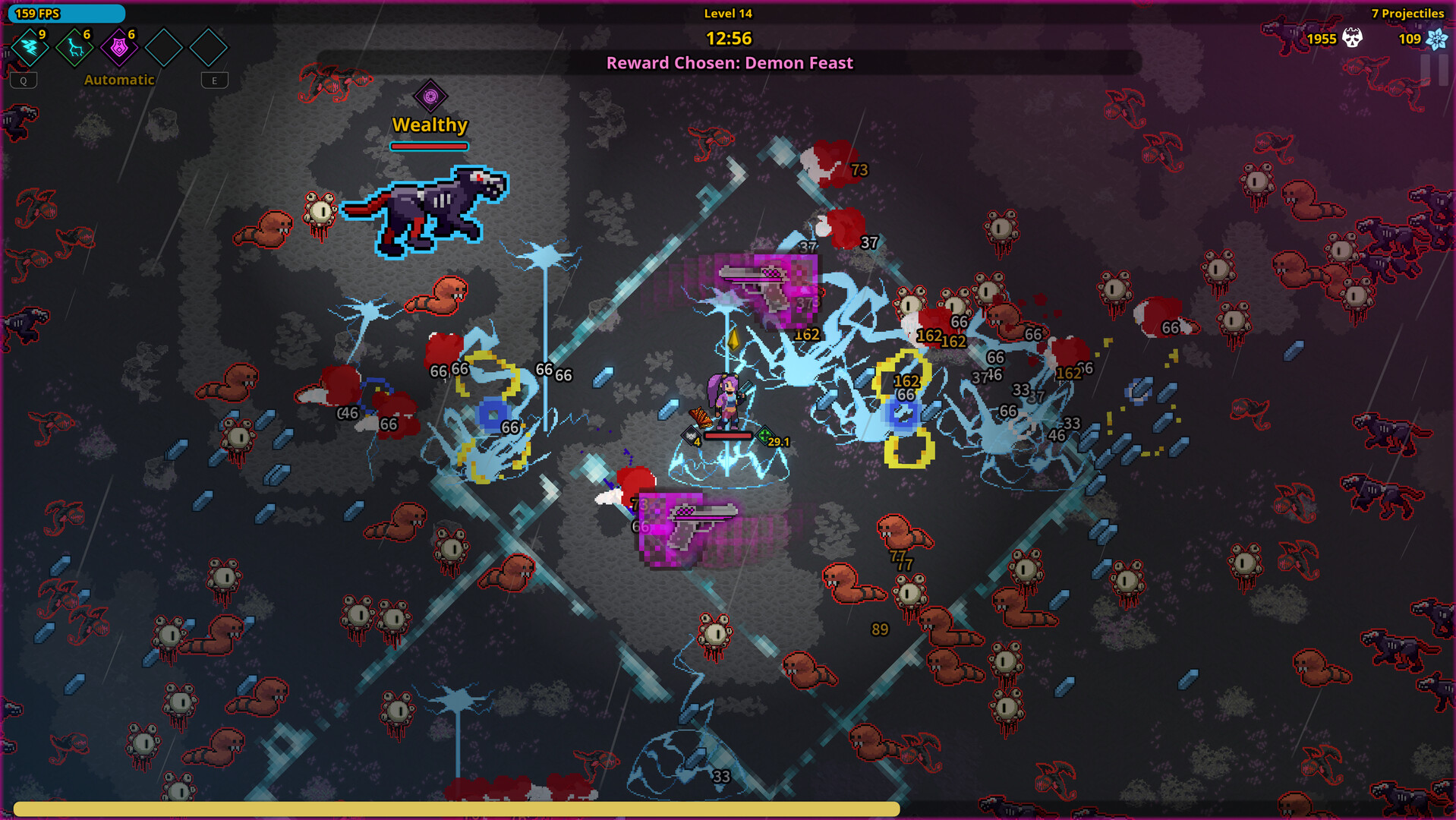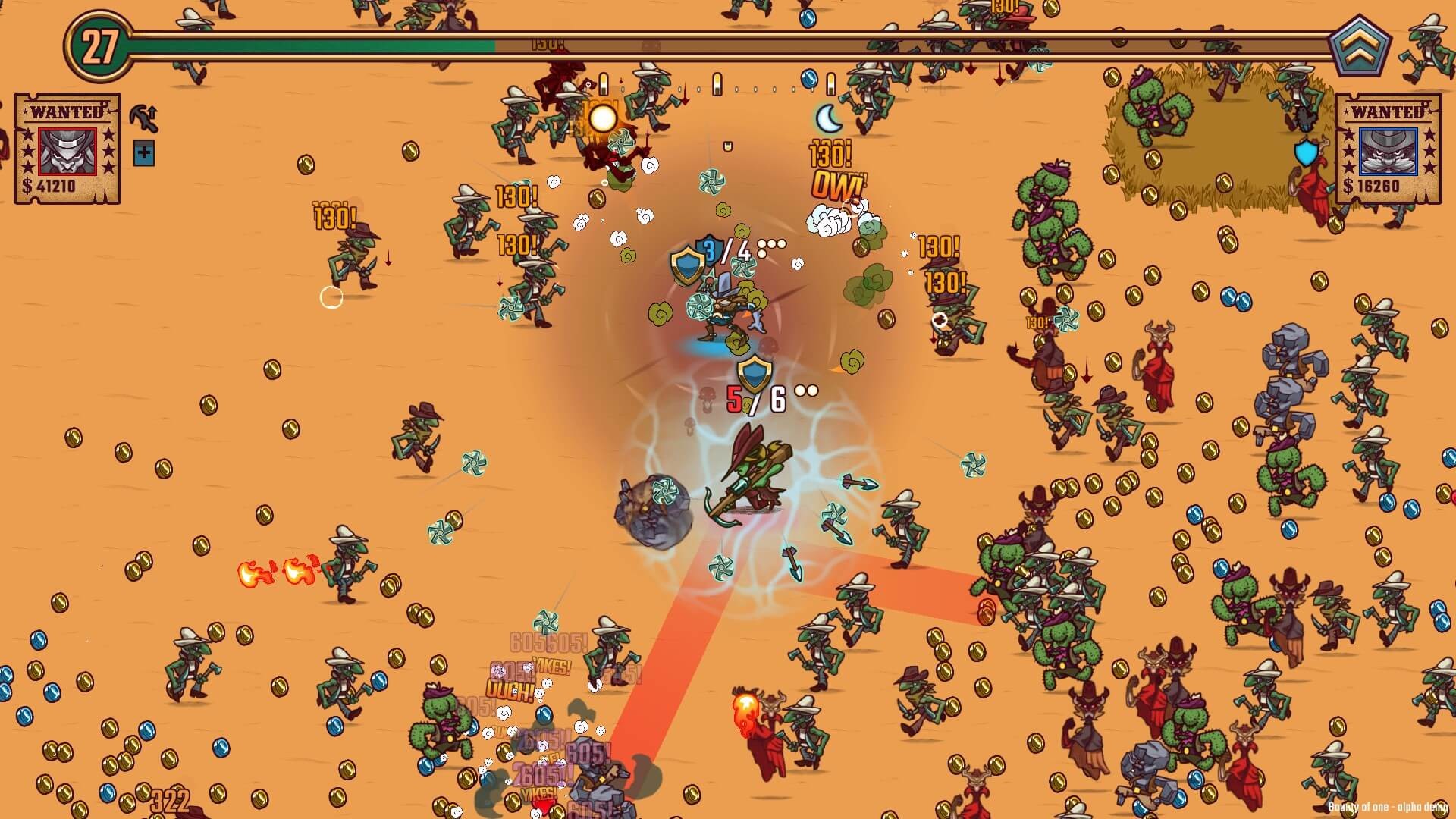Surviving Bullet Heaven
The 2021 release of Vampire Survivors spawned a whole cottage industry of budget games that continues to grow every day. For some reason, I've played over a dozen of them.
Some call them "survivor-likes". Others refer to them as "bullet heavens", a play on the infamous "bullet hell" style of arcade shoot-em-ups. Some cheeky bastards (guilty as charged) prefer the term "auto-shooting survival", which can be conveniently abbreviated to "ASS". Whatever one may call this burgeoning genre of budget indie titles, there's no denying that Vampire Survivors is to blame. Roughly 4-5 million people have played the game on Steam alone, and in the year and a half since its release, dozens of similar games have sprouted up intent on capturing some of Vampire Survivors' magic.
Even if you haven't been following the "auto-shooter" craze, you may have noticed more and more games popping up with the following characteristics:
- A relatively low price of $3-$5
- Early Access (or some other form of ongoing open beta access)
- Top-down or isometric POV
- Rogue-lite mechanics (run progress is lost upon death, but players can unlock new characters and incremental permanent upgrades between runs)
- Increasingly large waves of enemies, often at the cost of performance
- Auto-firing abilities that fill the screen with projectiles and effects (also at the cost of performance)
- Short runs, usually under 30 minutes
Due to the bite-sized nature of these games—in terms of both price and scope—I've been picking up pretty much any auto-shooter that seem remotely interesting. Here's a list of what I've tried as of May 2023, beginning with the game that started it all and proceeding through a dozen big(ish) names in the genre. It's not an exhaustive list, nor one that covers all the nuances of the games' systems. Nonetheless, I hope it will serve as a suitable introduction for those new to the survivor-like/bullet heaven/ASS genre or a guide for existing fans looking for more recommendations. Let's start at the beginning, which might not actually be the beginning depending on who you ask...
Vampire Survivors
While not technically the first game of its kind (people have pointed to Deathstate and Magic Survival as early games in the genre), Vampire Survivors is undoubtedly the progenitor of the auto-shooter zeitgeist. It initially launched for under $3 and quickly took the internet by storm for its 'legally distinct from Castlevania' art style, absurd power creep, and hilariously poor optimization that caused even moderately viable builds to tank players' framerates, especially when weapons are "evolved" and fire nonstop in every direction. After about 15 minutes, the average player's screen will be filled with flying swords, chain lightning, garlic-powered death zones, and more. All of these qualities gave Vampire Survivors an irresistible charm, and the game has only gotten better with the addition of more characters, weapons, upgrades, and levels (some of which are locked behind two $1.99 DLC packs that are easily worth the price of admission). Over two years after its initial release, Vampire Survivors remains a titan of the genre and fantastic starting point for new players.
Void Scrappers
Void Scrappers is notable for being both a relatively early addition to the genre and one of the first with a sci-fi theme (another one will appear further down this very list). The speed and maneuverability of the player ship is exhilarating, especially when using the very generous (invincible) dash. Then we have the unlockable weapons which build on the formula established by Vampire Survivors by adding an impressive sci-fi arsenal, including orbiting melee drones, laser-refracting prisms, and bullets that boomerang back towards their source, just to name a few. The result is a game that feels very different than almost any other auto-shooter I've played, both in terms of controls and potential builds.
Although the game is no longer in Early Access, I wouldn't exactly call it finished. Enemies are one-dimensional, simply chasing after the player and/or shooting occasional projectiles. The developer also released a patch last month that introduced asteroids, which sounds like a neat idea, but the reality is that this is the only random event that occurs outside of enemy/boss spawns. I'd love to see some more variety, such as enemies carrying loot/powerups or different types of enemy waves. There haven't been any updates since the asteroid patch, though, and it appears that the devs have moved on to their new game. Still, Void Scrappers is worth checking out if you like going fast and blowing up aliens.
Holocure
Yes, it's a free fan-game based on characters from the Hololive streamer empire. No, I don't care about any of those people or their cartoon avatars—I just want to run around, filling the screen with hilarious weapon effects, and Holocure is a solid way to do just that. There are over a dozen characters, each with their own starting weapons and abilities (a departure from the aforementioned games which allow you to eventually use everything with everyone). The game also offers a few different ways to makes builds even more overpowered, such as the ability to gamble small amounts of in-game currency (the same used for permanent account upgrades) to for a chance to push weapons and buffs past their max levels and special "collabs" created by combining two fully upgraded weapons into new forms of anime mayhem. Lava buckets crash into the ground like meteors, throwing axes whirl in a protective circle around the player, bottles of sake explode into freezing snowflakes, and more. Most of the items and enemies are inside jokes that (thankfully) go right over my head, but they make for an undeniably entertaining auto-shooter. Holocure has no right being this good, especially for the low, low price of free.
Boneraiser Minions
The appropriately named Boneraiser Minions is one of the most mechanically unique auto-shooters out there, and while I am really, really bad at it, the game takes the genre's conventions in a completely different direction than many of its contemporaries. The player character cannot directly damage enemies in most situations; rather, the titular boneraiser must summon a horde of titular minions to do their bidding, and this is where the rogue-lite formula comes into play. Skellies can be upgraded, evolved, and combined, and the various characters and abilities are predominantly geared towards building bigger, badder undead armies. Want a giant skeleton to punch your foes to death with its bony fists, or tiny imps that lay deadly traps (into which you can then lead unsuspecting enemies), or even passive spirits to grant you and your summons health boosts? Or, to cut right to the chase, do you enjoy summon builds in ARPGs like Diablo and Path of Exile? If so, Boneraiser Minions is definitely worth playing.
Now, I mentioned above that I'm not great at Boneraiser Minions, and I think that part of the reason is that while I'm used to games in this genre automatically aiming and firing, the friendly AI adds another element of gameplay that is out of my control. Minions generally just follow the player, which is fine; however, there were often moments when staying close to my skellies was not practical, and when I dodged to safety, my minions took their time catching up, which in turn led to me getting surrounded again. This is likely a "me" problem, so I can't hold it against the game.
Rogue Genesia
The most immediately striking thing about Rogue Genesia is its art style, characterized by the same sort of 2D tilt-shifted look that has defined recent Square Enix RPGs like Octopath Traveler and Live a Live. The surprises don't stop there, though. In Rogue Genesia's primary game mode, the progression of each run is determined through a series of branching paths a la FTL and Slay the Spire, allowing the player to customize the levels of risk/reward as they go. Want to fight several bosses in a row? Step right up. Would you rather test your luck with a random event? Roll the dice! For folks who prefer to just tough it out for a standard 30 minute run, the typical "survivor" style mode is there, but it doesn't feel nearly as rewarding or engaging as the roguelite option.
With this said, the gameplay loop is fairly unremarkable overall, but it's by no means bad. We've got the usual assortment of melee weapons, magic projectiles, and area-of-effect spells, and there are no unique character classes as of yet to add variety to different builds. Still, Rogue Genesia is a solid game with a promising future, especially considering that it's still in Early Access. There's also a free demo on Steam—hopefully the developer doesn't remove it after the game's release (a common trend these days).
Halls of Torment
Halls of Torment not only looks like a mod for the original 1997 Diablo—it takes direct inspiration from the legendary ARPG to add a fresh spin to the auto-shooter formula. Certain bosses and chests drop armor that can either be equipped or sent to the surface via a well (one use per run) to permanently unlock the item for future runs. These armor pieces grant bonuses to attack speed, pickup range, and blocking, with a few offering unique abilities e.g. dropping caltrops when the player takes damage or summoning skeletal minions every 15 seconds. At the ends of doomed runs (of which there were several in my first few hours), I raced to the well to bank my best piece of gear before getting overrun by demons. Add to this a bestiary of enemies that range from mindless, shambling skeletons to ARPG-style boss monsters with telegraphed attacks as well as a diverse playable roster that includes a flamethrower-toting exterminator and a warlock who summons seeking skulls, and Halls of Torment is off to a strong start. Here's hoping that the devs continue to build on this solid foundation for the game's full release.
Crafty Survivors
Crafty Survivors is another oddball that could technically be classified as an auto-shooter, but in my experience, it is better as a more traditional twin-stick horde survival game. The randomized skills picked up during each run appear on a hotbar at the bottom of the screen, and players can choose which of these skills they would like to manually trigger and which they would prefer to have fire automatically once the cooldown is up. This offers a level of flexibility that I haven't seen from any other game in the genre—as noted above, these types of settings are usually a simple all-or-nothing toggle. Now, since every skill has its own cooldown and most skills need to be aimed, it's usually unwise to set everything to auto-fire, so players will need to be a bit more attentive and engaged than with some other titles on this list.
What truly set Crafty Survivors apart from its contemporaries are the character classes and progression systems. Each class is mechanically complex and unique in their own ways, such as a chef who combos different flavored status effects for big damage or a sculptor who places blocks on the field and "carves" them into a variety of totems (this process conveniently blasts enemies on the other side of the statues with shrapnel). As the player progresses through the relatively short levels, they gather gold and natural resources which are then spent to unlock new classes and a variety of services in town. Between runs, one can repair buildings to earn the standard permanent upgrades to attack and HP, but there is also the option to cook food to earn buffs, or deposit gold in the bank to accrue interest. In its current state Crafty Survivors is rather stingy with healing and upgrades early on, but once you get going, the game is full of fun surprises and stands on its own as an impressive little survival roguelite.
Time Wasters
Finally—someone cut right to the heart of the genre in two simple words.
Obviously, I'm kidding, though Time Wasters is a bit of a mixed bag. Simply put, the first few runs of Time Wasters are bewildering. Icons immediately fill the edges of the screen, marking planets and space stations that offer unique bonuses on timers. Players are prompted to pick up blue time cubes (currency for the current run) and purple space cubes (global unlock currency). There is a tanky yellow ship that flies around siphoning up extra XP until the player destroys it. To the game's credit, it is able to communicate almost all of this through gameplay alone, but the screen does get fairly busy and hard to parse at times.
In some ways, it's clear that the developers have learned quite a few lessons from other games in the genre. Weapons aim and fire automatically but can be manually aimed when necessary. Level-up rewards don't pop up automatically and interrupt the player; rather, they can be selected by via button press whenever the player has a moment to spare. My favorite element is how an enemy's HP can be tracked by simply looking at its model, which gradually turns red as it takes damage. No more health bars cluttering the screen! With this said, Time Wasters can often feel unfair, especially in the early game when the player is scrambling for weapons and upgrades. Enemy ships are extremely aggressive, to the point where it is far too easy to get overwhelmed. This is made worse by the fact that there is no "grace period" when the player is hit—it's possible for one's shields and hull to be instantly melted away in a matter of seconds unless one selects a particular perk that will buy them an extra second or two to escape. Numerous runs ended with me getting swarmed by ships faster than I could react or by bosses chasing me straight into the edge of their arena, which conveniently deals heaps of damage. Some invincibility frames or speed upgrades would go a long way. I enjoy Time Wasters' second-to-second gameplay, but cracks start to show as runs progress.
* * *
This marks the end of my general recommendations. The games that follow are not necessarily bad games or poor entries in the genre. Rather, the next six titles just didn't click with me in a way that made me want to play more than an hour or two. Your mileage my vary.
20 Minutes to Dawn
Of all the games mentioned here, 20 Minutes to Dawn comes the closest to bridging the gap between games like Crimsonland, an old favorite of mine that enhanced the twin-stick/horde shooter formula with an engaging perk system, and this new breed of auto-shooting mayhem. In addition to choosing a specific character, players also choose a starting weapon, which will have to be aimed, fired, and, eventually, reloaded. Ammo is infinite, but the discrete magazine sizes and short but noticeable reload animations add some tension to the mix. The game compensates for this by adding abilities that specifically synergize with these gun mechanics: for example, a double-barrel shotgun pairs nicely with skills that fire when the gun is emptied, and damage-over-time effects work especially well on weapons with a wide spread. Thus far, there is one significant downside, which is that healing is extremely hard to come by unless you spec into a specific perk/tree during a run or unlock a node at the permanent upgrade tree—enemies do not drop healing items. The result is a game that feels unusually punishing until one is able to grind out the souls necessary to obtain the healing nodes on the tree.
Spellbook Demonslayers
Spellbook Demonslayers is another solid auto-shooter that doesn't quite rise to the top for me, but I still enjoyed my time with it. The game's main distinguishing feature is the shrine, a randomly spawned tower that grants a temporary buff when the requisite number of enemies is killed within a certain radius. This is similar to how Time Wasters encourages players to move to specific locations rather than lead enemies around in a circle, though I will say that Spellbook Demonslayers came out first. Things can get pretty hectic when several shrines' circles overlap, leading to some interesting tension; the issue is that I kept running into the same shrines over and over again. Thus, while the game feels good to play even in this relatively early state, I wish that there was more that stood out about it. I'll keep an eye on this one.
Nomad Survival
As one of the earliest games to follow in Vampire Survivors' wake, Nomad Survival definitely tried to differentiate itself—with limited success. Various "events" occur every few minutes, such as chests that need to be broken open and veils of darkness limiting the player's field of view. The player can also choose a pet to follow them around and offer support, whether in the form of attacking enemies or nabbing collectibles. I'll have to spend more time with this one before I'm able to pass judgment, but I haven't exactly been hooked by the gameplay so far. The main downside is that the UI and controller support leave a lot to be desired. Vampire Survivors isn't exactly a pretty game, but Nomad Survival is even rougher around the edges. Unfortunately, the developer has stated that they're not going to be updating the game any further outside of bugfixes, so this is one of the few games on the list that is completely finished, for better or worse.
Brotato
A lot of people love Brotato, and while I'm not necessarily one of them, that doesn't mean that I dislike the game. Enemies are destroyed with a satisfying "pop", and the different characters and weapons lead to some neat combinations, such as the one melee-only run in which my character became a whirling dervish of fists, knives, and clubs—I just didn't find it nearly as addictive or varied as some of the others on this list. The levels are small and claustrophobic, and without a dash ability, I kept getting boxed in around the same point in each run. Nonetheless, Brotato is a simple and satisfying wave-based auto-shooter for under $5, so you can't really go wrong if you need something to pass the time.
Scarlet Tower
I suspect that this game has a lot more depth as you get further into the meta-progression, but I found my first hour in Scarlet Tower to be fairly boring. The game looks nice, particularly its particle effects; however, it fails to distinguish itself from Vampire Survivors on a minute-to-minute level, with some weapons that are almost identical to their VS counterparts (most notably the Bible and Holy Water, which were already "borrowed" from Castlevania) and combat that is merely satisfactory once you get past all the glowing projectiles. The bosses are damage sponges, even with several maxed-out weapons, and to make matters worse, I didn't see any option to "evolve" weapons into new, more interesting forms. The final nail in the coffin for me was what appeared to be a needlessly complicated metagame. Each character has upgradeable character abilities, but there is also a 20 Minutes to Dawn-style skill system, unlockable racial bonuses, account-wide skill upgrades, an upgradeable "familiar", and a rune system that was recently added that I didn't even get to try yet. As mentioned above, I'm sure that these will eventually lead to satisfying progression, but the three runs that I did play were not inspiring. This one needs more time in the oven.
Bounty of One
Incoming subjectivity! This is the only game on this list that I actively disliked.
In addition to having the least appealing aesthetics (graphically and sonically), Bounty of One is also the least fun to play. You see, the player character only fires their weapon while standing still. The first few builds that I created were fun enough (such as a dash-based character who dealt various types of area-of-effect damage before, during, and after dashes; and a character whose shots split, chained, and pierced), but having to stop moving to deal damage put a damper on my enthusiasm. I also found the bosses to be fairly tedious, a feeling made worse when I realized that the bosses were the same (and fought in the same order) every time. In the end, this one just wasn't for me, which is a shame because it's the only game on the list with local co-op.
* * *
This is a good place to stop for now. I've clearly played too many of these, but since I have yet to grow tired of the genre, a part 2 of this article may turn up in the near future. I'll likely continue trying them out as long as the games keep coming (and stay cheap)!




